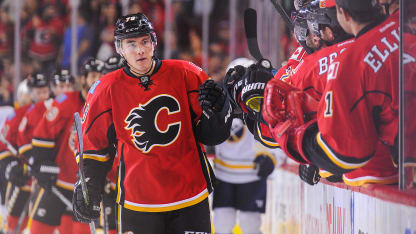BOSTON, MA -- Last year, Calgary Flames assistant coach Martin Gelinas wasn't sure what to make of Micheal Ferland.
The forward's style of play seemed to change from shift to shift and consistency was an issue as he navigated his way through the challenges of playing a full year in the NHL.
There were flashes of the power-forward game he played during his junior days in the Western Hockey League and with the Flames' American Hockey League affiliate clubs but they were just that - flashes.
This season, it's a different story.
"Last year, you didn't know when you put Ferly (on the ice) what would happen. He's got a gift offensively but defensively, sometimes you wondered. Now, he's playing on both sides of the puck and it's nice to see," Gelinas told CalgaryFlames.com.
"He's more mature ... he's more focused now. I think he knows he belongs. He's more confident. His overall game has grown. He's reliable. He's producing."
Ferland's progression yielding strong results
Micheal Ferland has seen his game blossom early on this season

© Derek Leung/Getty Images
Ferland has settled in with head coach Glen Gulutzan and embraced the role he has been given by the coaching staff. They have asked the 24-year-old to play a more simplistic style of hockey - a balanced, three-and-three game each night, in which the aim is to get approximately three shots on net and three hits per game.
The result?
He has already tied his 2015-16 goal total at four and has nine points through 22 games - which is no surprise when you look at his underlying numbers. Ferland has been one of Calgary's top forwards when it comes to driving the play and generating chances.
Among Flames skaters with 10 or more games played this season, he's fourth in five-on-five shot attempt percentage (54.19 percent) and is second in points-per-60-minutes (2.27) - even more impressive when you take into account he is average 10:48 of ice time per game.
He hasn't been sheltered by his coaches, being tasked with plenty of defensive zone starts (77 compared to his 51 offensive zone starts) and has been sent out to shut down other team's top lines on multiple occasions.
To compare Ferland's play this year and measure how far he's come, at the 22-game juncture last year, he had one goal and three points and was a minus-4.
"I really think he's developed a really strong base this first 20 games," Gulutzan explained. "It's probably time that we give him a little more. But we wanted to work on the foundation first and he's done a really good job of it. I'm really impressed with his work and his play and his demeanor.
"I knew what he had. I knew how good of a young man he was back in junior, having worked with him with Saskatoon. But he's really impressed me."
Seeing the strides he has made, the coaching staff has worked Ferland onto one of their power play units - a role he has thrived in. Last year, he netted a single power play goal in 73:45 of ice time with the man-advantage. This year, in just 22 games and 14:26 of power play ice time, he already has two power play markers.
At 6-foot-2 and 208-pounds, he's a perfect candidate to park in front of the net to screen the goaltender and try and deflect shots from the point into the net but he isn't a one-dimensional player on the power play. He has the skill to make plays and set up his teammates, the frame to push past penalty killers and is armed with a heavy, accurate shot.
"That's a role I really enjoy," Ferland said when asked about his increased power play time. "Hopefully I can stay on there."
In addition to his offensive success, Ferland has provided the team with the physical presence he has become known for. He is second to only Troy Brouwer in hits this season with 50 and has averaged 2.3 hits-per-game thus far.
Ferland has always enjoyed playing that style of game - as evidenced by the incredible 50 hits he threw in nine games in the 2015 Stanley Cup Playoffs - but has a better understanding of how to manage the workload that comes with that role. Instead of concentrating on throwing as many checks as possible, he has been picking his spots.
"It's good. It's tiring sometimes," he acknowledged. "You see where you don't get a hit for maybe a couple of periods ... it takes a lot of energy out of you.
"You go out there and in your first couple of shifts, you make a hit and you're kind of winded and you want to catch your breath. You've just kind of got to maintain it and not just go out there and be flying around, hitting everyone."
Ferland can't pinpoint a single reason as to why his development appears to be on the fast-track this year, noting that experience has likely played the biggest role in his progression. After going through an up-and-down 2015-16 season, he has more confidence in his abilities and has a better grasp of the game.
"Playing at this level has just made me a better player. I kind of went through stages like that in junior - every year, I kept getting better and better. I feel the same right now."
He is also more even-keeled on the ice. If something doesn't go his way, he has the experience to know how to work through it.
"If I'm not having a good game or if I'm not getting shots, not playing in the offensive zone, I can start being more physical and (help) out that way."
Seeing Ferland reap the benefits of playing more reliable, two-way game on the scoresheet has been a pleasure for Gulutzan, who sees plenty of untapped potential in the winger.
"We wanted to establish a good defensive base and he's done it. There's still things he needs to work on, defensively, but we wanted to establish that. He established it himself. He took initiative to do it. He's playing well.
"Now the rest of his game starts to blossom from his base."


















